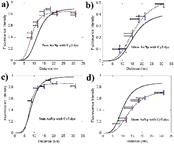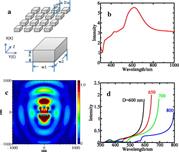Computational Chemistry and Nano Materials for Renewable energy
 Professor of Chemistry
Professor of Chemistry
B.S. Shandong University
Ph.D. Emory University
Phone: 407-823-4123
Email: shengli.zou@ucf.edu
Research Positions in Dr. Zou’s Lab on Computational Chemistry and Nanomaterials for Renewable Energy (Undergraduate and Graduate Opportunities Available)
Graduate Students
We welcome motivated students to join our research group. Prospective graduate students are encouraged to contact Dr. Zou directly to learn more about available opportunities.
If you are interested in applying to the graduate program in the Department of Chemistry at the University of Central Florida, please visit the College of Graduate Studies website for more information.
Undergraduate Students
We welcome motivated undergraduate students interested in gaining research experience in computational chemistry and renewable energy. If you’re curious driven, and eager to contribute to cutting-edge research, please contact Dr. Zou to inquire about available opportunities in our group.
Group members
Outreach Activities
Online module
Computational simulations for chemical measurement
RESEARCH:
1. Catalytic reaction using non-metallic catalyst for renewable energies and pharmaceutical applications.
Using quantum mechanics theory and machine learning, we are interested in modeling catalytic reactions involving transition metal elements or non-metallic catalyst for renewable and sustainable energies as well as pharmaceutical applications. For example, water splitting, N2 fixation, CO2 reduction, C-H bond activation.
2. Developing new algorithm to find analytical solution of Schrodinger equation of three body system or solve Schrodinger equation starting from Newton’s equations of motion.
Exact solution of Schrodinger equation for three body system, like He atom, is still behind our view. We are interested in developing new algorithms, approaches, or series of functions to tackle the problem.
Equations in classical mechanics will fail in predicting quantum phenomenon. However, classical mechanics provides us a picture which is much easier to comprehend. In combination of De Broglie’s postulate, Heisenberg’s uncertainty principle, and Newton’s equation of motion, we found that wave functions of Schrodinger can be reproduced with excellent agreement with the analytical solution. We are interested in developing new algorithms to bridge the gap between classical and quantum mechanics.
3. Energy transfer between dye, quantum dot and metal nanoparticles.
Using electrodynamics theory, we model the energy transfer between dye molecules or quantum dots when they are placed near one or multiple nanoparticles. The intensity and life change of the emitter when it is placed near a metal nanocluster can be calculated. Both the single and multiple excitons process can be modeled.

Fig. 1 Schematic of the energy transfer between a dye or a quantum dot placed near a metal nanoparticle.


Figure 2. Experimentally measured and theoretically calculated fluorescence signal versus the distance between the dye molecules and Au nanoparticle surfaces.
4. Surface enhanced Raman scattering.
Quantitative agreement between the experimental measurement and theoretical calculations for the surface enhanced Raman scattering was obtained.

Figure 3. Experimentally measured and theoretically calculated enhancement factors of Raman scattering.
5. Optical properties of metal nanoparticles and particle arrays and films with periodic structures.
Using electrodynamics theory, we predict novel optical properties of metal nano clusters or particles arranged in a periodic arrays.



Figure 4. Complete light trapping using a two layer silver film with a thickness of 100 nm. (Left) Schematic of the film. (Middle) Electric field distribution between the two layers. (Right) Absorption efficiency between wavelengths of 300-800 nm. The simulations can be used to design solar cells with reduced dimension and improved efficiency.


Figure 5. Theoretical demonstration of efficient light propagation through a 50 nm wide tunnel with multiple sharp 90 degree turns. The calculations showed efficient light propagation after four sharp 90 degree turns and are useful for the design of optical waveguide devices.


Figure 7. Far field photon intensity enhancement using an array of silver nanoparticles. (Left) Schematic of the structure and principle of the far field photon enhancement. (Right) Numerical results showing the enhanced far field intensity using a silver nanoparticle array. Combining two coherent light rays is technically challenging. We demonstrated that combing multiple coherent rays is possible by using metal nanoparticle array with excited quadrupole mode.
LECTURES:
CHM3422 (Applied Physical Chemistry)
CHM3411 (Physical Chemistry II)
CH6240 (Chemical Thermodynamics)
PUBLICATIONS
[Complete list] [Google Scholar] [Research Gate]
1. “Coupling and Energy Transfer between an Exciton in a Semiconductor Quantum Dot and a Surface Plasmon in a Metal Nanoparticle”, Abrahan J. Martinez, Ankai Wang, Mariam Khvichia, Jin Z. Zhang, Shengli Zou, Journal of Physical Chemistry Letters, 2025, 16, 985-990
2. “Radiative Decay Rate Enhancement and Quenching for Multiple Emitters near a Metal Nanoparticle Surface” Yadong Zhou, Gang Chen, Shengli Zou, Journal of Physical Chemistry C, 2021, 125 (4), 2531–2536
3. “An experimental and theoretical mechanistic study of biexciton quantum yield enhancement in single quantum dots near gold nanoparticles” Swayandipta Dey, Yadong Zhou, Xiangdong Tian, Julie A. Jenkins, Ou Chen, Shengli Zou, Jing Zhao, Nanoscale (2015) 7(15), 6851-6858
4. “Failure and Reexamination of the Raman Scattering Enhancement Factor Predicted by the Enhanced Local Electric Field in a Silver Nanorod” Yadong Zhou, Yan Tian, Shengli Zou, Journal of Physical Chemistry C, (2015) 119(49), 27683-27687
5. “A numerical demonstration of far field photon intensity enhancement without stimulated emission” Patricia Gomez, Jennifer M. Reed, Haining Wang, and Shengli Zou, Chemical Physics Letters (2014) 616, 243-247
6. “A generalized electrodynamics model for surface enhanced Raman scattering and enhanced/ quenched fluorescence calculations” Haining Wang, Shengli Zou, RSC. Adv. (2013) 3(44) 21489-21493
7. “Controlling the Shape, Orientation and Pitch of Carbon Nanotube Features Using Nano Affinity Templates” Yuhuang Wang, Daniel Maspoch, Shengli Zou, George C. Schatz, Richard E. Smalley, Chad A. Mirkin, Proc Nat Acad Sci, USA (2006) 103,2026-2031
8. “Silver nanoparticle array structures that produce giant enhancements in electromagnetic fields” Shengli Zou and George C. Schatz, Chem. Phys. Lett, (2005) 403(1-3) 62-67.
9. “Finding sharp extinction peak in one and two dimensional silver nanoparticle arrays”, Shengli Zou, Nicolas Janel, George C. Schatz, J. Chem. Phys., (2004) 120, 10871-10875.